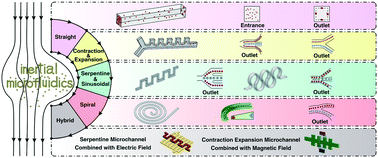Computational inertial microfluidics: a review†
Abstract
Since the discovery of inertial focusing in 1961, numerous theories have been put forward to explain the migration of particles in inertial flows, but a complete understanding is still lacking. Recently, computational approaches have been utilized to obtain better insights into the underlying physics. In particular, fundamental aspects of particle focusing inside straight and curved microchannels have been explored in detail to determine the dependence of focusing behavior on particle size, channel shape, and flow Reynolds number. In this review, we differentiate between the models developed for inertial particle motion on the basis of whether they are semi-analytical, Navier–Stokes-based, or built on the lattice Boltzmann method. This review provides a blueprint for the consideration of numerical solutions for modeling of inertial particle motion, whether deformable or rigid, spherical or non-spherical, and whether suspended in Newtonian or non-Newtonian fluids. In each section, we provide the general equations used to solve particle motion, followed by a tutorial appendix and specified sections to engage the reader with details of the numerical studies. Finally, we address the challenges ahead in the modeling of inertial particle microfluidics for future investigators.



 Please wait while we load your content...
Please wait while we load your content...